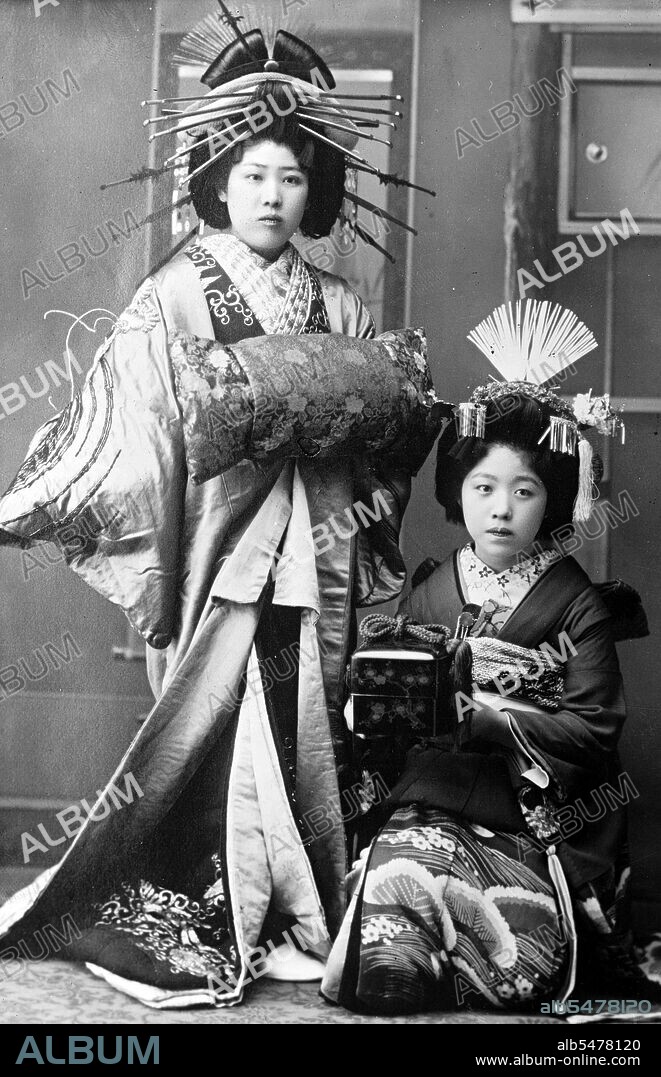alb5478120
Japan: Two late 19th century oiran or courtesans-prostitutes

|
Zu einem anderen Lightbox hinzufügen |
|
Zu einem anderen Lightbox hinzufügen |



Haben Sie bereits ein Konto? Anmelden
Sie haben kein Konto? Registrieren
Dieses Bild kaufen

Titel:
Japan: Two late 19th century oiran or courtesans-prostitutes
Untertitel:
Automatische Übersetzung: Oiran (??) waren die Kurtisanen des Japans der Edo-Zeit. Die Oiran galten als eine Art Yujo (??), ?Frau der Lust? oder Prostituierte. Sie unterschieden sich jedoch von den Yujo dadurch, dass sie Unterhaltungskünstlerinnen waren, und viele wurden außerhalb der Vergnügungsviertel zu Berühmtheiten ihrer Zeit. Ihre Kunst und Mode setzten oft Trends unter den Reichen, und aus diesem Grund werden kulturelle Aspekte der Oiran-Traditionen bis heute bewahrt. Die Oiran entstanden in der Edo-Zeit (1600-1868). Zu dieser Zeit wurden Gesetze erlassen, die Bordelle auf ummauerte Viertel in einiger Entfernung vom Stadtzentrum beschränkten. In den großen Städten waren dies das Shimabara in Kyoto, das Shinmachi in Osaka und das Yoshiwara in Edo (dem heutigen Tokio). Diese wuchsen schnell zu großen, in sich geschlossenen ?Vergnügungsvierteln? heran, die alle Arten von Unterhaltung anboten. Innerhalb der Kurtisane wurde der Geburtsrang nicht berücksichtigt, was ein Glück war, da viele der Kurtisanen Töchter verarmter Familien waren, die als Vertragsknechte in diesen Lebensstil verkauft wurden. Stattdessen wurden sie nach Schönheit, Charakter, Bildung und künstlerischem Talent kategorisiert. Unter den Oiran galt der Tayu (??) als der höchste Rang einer Kurtisane und wurde als geeignet für die Daimyo oder Feudalherren angesehen. Mitte des 18. Jahrhunderts begannen die Kurtisanen-Ränge zu verschwinden und Kurtisanen aller Klassen wurden kollektiv einfach als ?Oiran? bezeichnet. Das Wort Oiran stammt von der japanischen Phrase oira no tokoro no nesan (????????), was übersetzt ?meine ältere Schwester? bedeutet. Auf Japanisch besteht es aus zwei Kanji, ? bedeutet ?Blume? und ? bedeutet ?Führende Blume? oder ?Erste Blume?.
Oiran (??) were the courtesans of Edo period Japan. The oiran were considered a type of yujo (??) 'woman of pleasure' or prostitute. However, they were distinguished from the yujo in that they were entertainers, and many became celebrities of their times outside the pleasure districts. Their art and fashions often set trends among the wealthy and, because of this, cultural aspects of oiran traditions continue to be preserved to this day. The oiran arose in the Edo period (1600–1868). At this time, laws were passed restricting brothels to walled districts set some distance from the city center. In the major cities these were the Shimabara in Kyoto, the Shinmachi in Osaka, and the Yoshiwara in Edo (present-day Tokyo). These rapidly grew into large, self-contained 'pleasure quarters' offering all manner of entertainments. Within, a courtesan’s birth rank held no distinction, which was fortunate considering many of the courtesans originated as the daughters of impoverished families who were sold into this lifestyle as indentured servants. Instead, they were categorized based on their beauty, character, education, and artistic ability. Among the oiran, the tayu (??) was considered the highest rank of courtesan and were considered suitable for the daimyo or feudal lords. In the mid-1700s courtesan rankings began to disappear and courtesans of all classes were collectively known simply as 'oiran'. The word oiran comes from the Japanese phrase oira no tokoro no nesan (????????) which translates as 'my elder sister'. When written in Japanese, it consists of two kanji, ? meaning 'flower', and ? meaning 'leader' or 'first', hence 'Leading Flower' or 'First Flower'.
Bildnachweis:
Album / Pictures From History/Universal Images Group
Freigaben (Releases):
Model: Nein - Eigentum: Nein
Rechtefragen?
Rechtefragen?
Bildgröße:
3291 x 5100 px | 48.0 MB
Druckgröße:
27.9 x 43.2 cm | 11.0 x 17.0 in (300 dpi)
Schlüsselwörter:
ASIEN • ASIEN, KONTINENT • FOTOGRAFIE • FRAU • FRAUEN • GESCHICHTE • HURE • JAPAN • JAPANER • JAPANERIN • JAPANISCH • KIMONO • KIMONOS • KONTINENT, ASIEN • KUNST • KURTISANE • MODE • MOMENTAUFNAHME • ORMNAMENT: JAPANISCH • PROSTITUIERTE • SEX • STIL • WEIBCHEN • WOMAN • ZEITGESCHICHTE
 Pinterest
Pinterest Twitter
Twitter Facebook
Facebook Link kopieren
Link kopieren Email
Email
